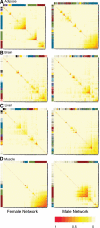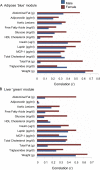Elucidating the role of gonadal hormones in sexually dimorphic gene coexpression networks
- PMID: 18974276
- PMCID: PMC2654741
- DOI: 10.1210/en.2008-0563
Elucidating the role of gonadal hormones in sexually dimorphic gene coexpression networks
Abstract
We previously used high-density expression arrays to interrogate a genetic cross between strains C3H/HeJ and C57BL/6J and observed thousands of differences in gene expression between sexes. We now report analyses of the molecular basis of these sex differences and of the effects of sex on gene expression networks. We analyzed liver gene expression of hormone-treated gonadectomized mice as well as XX male and XY female mice. Differences in gene expression resulted in large part from acute effects of gonadal hormones acting in adulthood, and the effects of sex chromosomes, apart from hormones, were modest. We also determined whether there are sex differences in the organization of gene expression networks in adipose, liver, skeletal muscle, and brain tissue. Although coexpression networks of highly correlated genes were largely conserved between sexes, some exhibited striking sex dependence. We observed strong body fat and lipid correlations with sex-specific modules in adipose and liver as well as a sexually dimorphic network enriched for genes affected by gonadal hormones. Finally, our analyses identified chromosomal loci regulating sexually dimorphic networks. This study indicates that gonadal hormones play a strong role in sex differences in gene expression. In addition, it results in the identification of sex-specific gene coexpression networks related to genetic and metabolic traits.
Figures





Comment in
-
Do these genes make me look fat?Endocrinology. 2009 Mar;150(3):1075-7. doi: 10.1210/en.2008-1586. Endocrinology. 2009. PMID: 19240263 No abstract available.
References
-
- Wizemann TM, Pardue M, eds 2001 Exploring the biological contributions to human health: does sex matter? Washington, DC: National Academies Press - PubMed
-
- Mendelsohn ME, Karas RH 2005 Molecular and cellular basis of cardiovascular gender differences. Science 308:1583–1587 - PubMed
-
- Blaak E 2001 Gender differences in fat metabolism. Curr Opin Clin Nutr Metab Care 4:499–502 - PubMed
-
- Mittendorfer B 2005 Sexual dimorphism in human lipid metabolism. J Nutr 135:681–686 - PubMed
-
- Arnold AP 2002 Concepts of genetic and hormonal induction of vertebrate sexual differentiation in the twentieth century, with special reference to the brain. In: Pfaff DW, Arnold AP, Etgen AM, Fahrbach SE, Moss RL, Rubin RT, eds. Hormones, brain, and behavior. San Diego: Academic Press; 105–135
Publication types
MeSH terms
Substances
Grants and funding
LinkOut - more resources
Full Text Sources
Medical
Molecular Biology Databases

